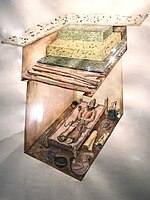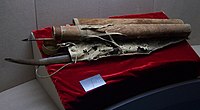Subeshi kültürü
Bu madde, öksüz maddedir; zira herhangi bir maddeden bu maddeye verilmiş bir bağlantı yoktur. (Ekim 2023) |
Subeshi kültürü (MÖ 1100-100, Bölüm: 苏贝希文化), aynı zamanda Subeishi veya Subeixi kültürü, Tarım Havzası'nın doğu ucundaki Turfan, Sincan bölgesinden bir Demir Çağı kültürüdür.[1] Subeshi kültürü daha sonraki dönem Tarım Mumyalarının bir kısmına katkıda bulunur. Çin tarihi kaynaklarından bilinen Cheshi devleti (車師, Chü-shih, Jushi Krallığı) ile ilişkili olabilir.[1][2] Kültür birbiriyle yakından ilişkili üç mezarlığı içerir:
Eserler[değiştir | kaynağı değiştir]
-
Yanghai mezarlığında mezar
-
Subeshi at eyeri.[6]
-
Subeshi veya Saka zırhı, MÖ 8.-3. yüzyıl.[7]
-
Ahşap nesneler, Yanghai mezarlığı, Subeshi kültürü
-
Subeshi kültürü çanak çömlek. Turfan Müzesi.[8]
-
Kask şeklinde kış kulaklığı şapkası, Subeshi mezarlığı.[9]
-
Shengjindian, Tufpan Müzesi'nden bir Subeshi kültürü yayı
-
Yanghai'den gelen asmanın Çin şarabının atası olduğu söyleniyor.[10]
-
MÖ 300 dolaylarında Shengjindian mezarlığından ahşap bir protez bacak, Turfan Müzesi. Bu, "bugüne kadar bilinen en eski fonksiyonel bacak protezidir".[11]
-
Yanghai-1'den halı, MÖ 7. yüzyıl.[12]
-
Yanghai-1'den halı, MÖ 7. yüzyıl.[12]
Ayrıca bakınız[değiştir | kaynağı değiştir]
Kaynakça[değiştir | kaynağı değiştir]
- ^ a b c Zhang, Kai (4 Şubat 2021). "The Spread and Integration of Painted pottery Art along the Silk Road" (PDF). Region - Educational Research and Reviews. 3 (1): 18. doi:10.32629/RERR.V3I1.242. 7 Haziran 2023 tarihinde kaynağından arşivlendi (PDF). Erişim tarihi: 24 Ekim 2023.
In the late Neolithic period and the early Bronze age, pottery, ornamentation and bronze culture with the characteristics of West Asia and Central Asia were introduced into Xinjiang, including Qijia culture (2500-1500 BC), Siba culture (about 2000-1600 BC), Chawuhugoukou culture (around 800-100 BC), Turpan Subeixi culture (1100 bc-100 BC) and other cultures.
- ^ Beck, Ulrike; Wagner, Mayke; Li, Xiao; Durkin-Meisterernst, Desmond; Tarasov, Pavel E. (20 Ekim 2014). "The invention of trousers and its likely affiliation with horseback riding and mobility: A case study of late 2nd millennium BC finds from Turfan in eastern Central Asia". Quaternary International. 348: 225-226. doi:10.1016/j.quaint.2014.04.056. ISSN 1040-6182.
The Yanghai graveyard is assigned to the Subeixi (Subeshi) culture (e.g. Jiang et al., 2006, 2009), conventionally dated to the first millennium BC (Chen, 2002; Han, 2007; Xinjiang, 2011). The culture is associated with the Cheshi (Chü-shih) state known from Chinese historical sources (Sinor, 1990).
- ^ Jiang, Hongen; Li, Cheng-Sen; Cao, Hongyong; Shading, Palidanmu; Cheng, Ye-Ming (July 2021). "Wood Utilization During the Late Bronze to Early Iron Age in the Turpan Basin of Xinjiang, China, With Special Emphasis on Betula (Betulaceae)". SAGE Open (İngilizce). 11 (3): 215824402110469. doi:10.1177/21582440211046950. ISSN 2158-2440. 27 Ekim 2023 tarihinde kaynağından arşivlendi. Erişim tarihi: 24 Ekim 2023.
- ^ Xin, Xiaoyu (2015). "Research on Prehistoric Hats in Xinjiang (2000 BC-200 BC)" (PDF). Asian Social Science. 16 Şubat 2019 tarihinde kaynağından arşivlendi (PDF). Erişim tarihi: 24 Ekim 2023.
- ^ Beaujard, Philippe (2010). "From Three Possible Iron-Age World-Systems to a Single Afro-Eurasian World-System". Journal of World History. 21 (1): 9, note 20. ISSN 1045-6007. 1 Kasım 2023 tarihinde kaynağından arşivlendi. Erişim tarihi: 24 Ekim 2023.
- ^ Wertmann, Patrick; Yibulayinmu, Maria; Wagner, Mayke; Taylor, Chris; Müller, Samira; Xu, Dongliang; Elkina, Irina; Leipe, Christian; Deng, Yonghong; Tarasov, Pavel E. (1 Eylül 2023). "The earliest directly dated saddle for horse-riding from a mid-1st millennium BCE female burial in Northwest China". Archaeological Research in Asia. 35: 100451. doi:10.1016/j.ara.2023.100451. ISSN 2352-2267. 26 Mayıs 2023 tarihinde kaynağından arşivlendi. Erişim tarihi: 24 Ekim 2023.
- ^ "Scale Armor Subeixi or Scythian". The Metropolitan Museum of Art (İngilizce). 6 Haziran 2016 tarihinde kaynağından arşivlendi.
- ^ Shao, Hui-qiu. "Research on the Subeixi Culture in Xinjiang" (PDF). 边疆考古研究. 1 Kasım 2023 tarihinde kaynağından arşivlendi (PDF). Erişim tarihi: 24 Ekim 2023.
- ^ Xin, Xiaoyu (2015). "Research on Prehistoric Hats in Xinjiang (2000 BC-200 BC)" (PDF). Asian Social Science. 16 Şubat 2019 tarihinde kaynağından arşivlendi (PDF). Erişim tarihi: 24 Ekim 2023.
- ^ Jiang, H. (2009). "Evidence for early viticulture in China: Proof of a grapevine (Vitis vinifera L., Vitaceae) in the Yanghai tombs, Xinjiang". Journal of Archaeological Science. 36: 1458–1465. doi:10.1016/j.jas.2009.02.010. 1 Kasım 2023 tarihinde kaynağından arşivlendi. Erişim tarihi: 24 Ekim 2023.
A stem was discovered in the Yanghai Tombs, Turpan District in Xinjiang, China. Anatomical features showed it to be of grape (Vitis vinifera L.). Radiocarbon dating indicates it to be nearly 2300 years old, which would suggest that there was grape cultivation at least from that time. To date, this is the earliest physical evidence of V. vinifera cultivation in China.(...) By the studying of the ancient grapevine, we have gained new insight into the viticulture in China. Based on the physical evidence, we have been able to confirm one of the conclusions drawn by Yang (2003), namely that the cultivated grape (V. vinifera) was introduced into Xinjiang around 300 BC. On the other hand, we would also argue that the earliest grape cultivation in China was not in the western and southern part of the Tarim Basin, but in the Turpan Basin, based on the evidence to date.
- ^ Li, Xiao; Wagner, Mayke; Wu, Xiaohong; Tarasov, Pavel; Zhang, Yongbin; Schmidt, Arno; Goslar, Tomasz; Gresky, Julia (21 Mart 2013). "Archaeological and palaeopathological study on the third/second century BC grave from Turfan, China: Individual health history and regional implications". Quaternary International. 290-291: 335–343. doi:10.1016/j.quaint.2012.05.010. ISSN 1040-6182. 2 Mart 2024 tarihinde kaynağından arşivlendi. Erişim tarihi: 24 Ekim 2023.
Ten radiocarbon dates on the prosthesis, human bones and wood pieces from the same grave suggest the most probable age of the burial is about 300–200 BC (68% confidence interval), thus introducing the oldest functional leg prosthesis known to date.
- ^ a b He, Zhang (2019). "Knotted Carpets from the Taklamakan: A Medium of Ideological and Aesthetic Exchange on the Silk Road, 700 BCE-700 CE" (PDF). The Silk Road. 17. 6 Mayıs 2020 tarihinde kaynağından arşivlendi (PDF). Erişim tarihi: 24 Ekim 2023.
Dated to as early as 700 BCE (Jia et al. 2009), the Yanghai carpet pieces are approximately three centuries older than the Pazyryk carpets (Rudenko 1970), making them the earliest knotted carpets found anywhere in the world.


![Koni şeklindeki yüksek sivri şapka, Subeshi mezarlığı.[4][5]](http://upload.wikimedia.org/wikipedia/commons/thumb/c/cd/Cone-shaped_high-peaked_hat%2C_Subeshi_cemetery.jpg/108px-Cone-shaped_high-peaked_hat%2C_Subeshi_cemetery.jpg)
![Subeshi at eyeri.[6]](http://upload.wikimedia.org/wikipedia/commons/thumb/5/59/Subeixi_saddle_-_Wertmann_et_al_2023.jpeg/176px-Subeixi_saddle_-_Wertmann_et_al_2023.jpeg)
![Subeshi veya Saka zırhı, MÖ 8.-3. yüzyıl.[7]](http://upload.wikimedia.org/wikipedia/commons/thumb/9/98/Subeixi_or_Saka_armour%2C_8th-3rd_century_BCE.jpg/106px-Subeixi_or_Saka_armour%2C_8th-3rd_century_BCE.jpg)

![Subeshi kültürü çanak çömlek. Turfan Müzesi.[8]](http://upload.wikimedia.org/wikipedia/commons/thumb/c/cb/Subeshi_culture_earthenware.jpg/166px-Subeshi_culture_earthenware.jpg)
![Kask şeklinde kış kulaklığı şapkası, Subeshi mezarlığı.[9]](http://upload.wikimedia.org/wikipedia/commons/thumb/e/e4/Helmet-shaped_earflap_hat%2C_Subeshi_cemetery.jpg/200px-Helmet-shaped_earflap_hat%2C_Subeshi_cemetery.jpg)

![Yanghai'den gelen asmanın Çin şarabının atası olduğu söyleniyor.[10]](http://upload.wikimedia.org/wikipedia/commons/thumb/e/eb/%E4%B8%AD%E5%9B%BD%E6%9C%80%E6%97%A9%E7%9A%84%E8%91%A1%E8%90%84%E8%97%A4.jpg/200px-%E4%B8%AD%E5%9B%BD%E6%9C%80%E6%97%A9%E7%9A%84%E8%91%A1%E8%90%84%E8%97%A4.jpg)
![MÖ 300 dolaylarında Shengjindian mezarlığından ahşap bir protez bacak, Turfan Müzesi. Bu, "bugüne kadar bilinen en eski fonksiyonel bacak protezidir".[11]](http://upload.wikimedia.org/wikipedia/commons/thumb/5/5f/Shengjindian_prosthetic_leg%2C_300-200_BCE.jpg/200px-Shengjindian_prosthetic_leg%2C_300-200_BCE.jpg)
![Yanghai-1'den halı, MÖ 7. yüzyıl.[12]](http://upload.wikimedia.org/wikipedia/commons/thumb/8/83/Yanghai_carpet%2C_7th_century_BCE.jpg/200px-Yanghai_carpet%2C_7th_century_BCE.jpg)
![Yanghai-1'den halı, MÖ 7. yüzyıl.[12]](http://upload.wikimedia.org/wikipedia/commons/thumb/2/2d/Yanghai_carpet%2C_7th_century_BCE_%282%29.jpg/200px-Yanghai_carpet%2C_7th_century_BCE_%282%29.jpg)